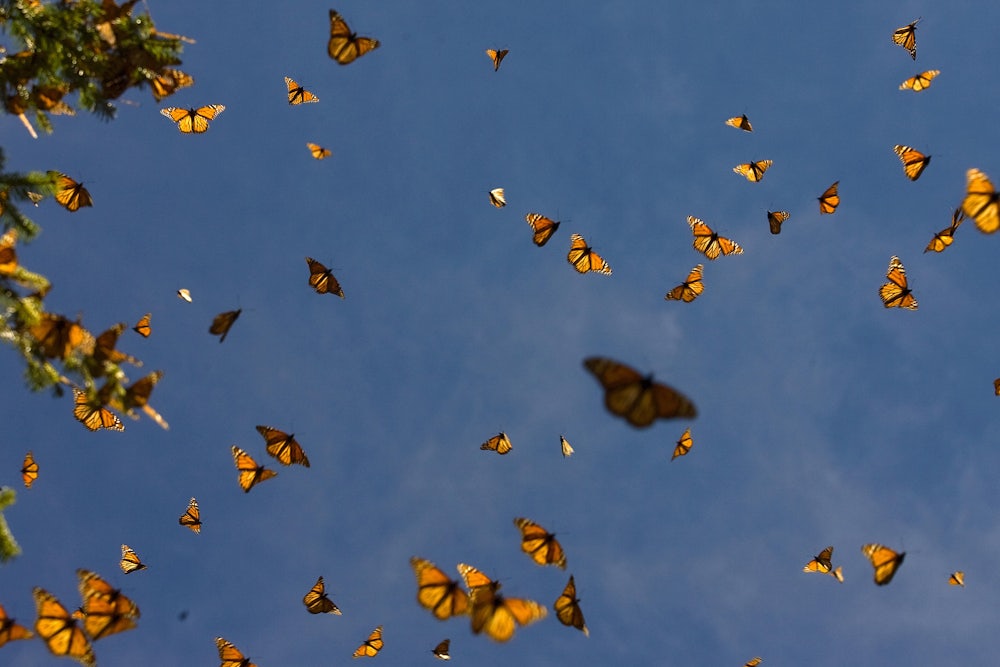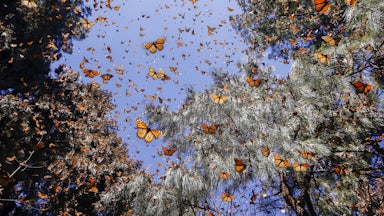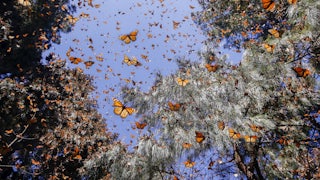In the 1980s, millions of monarch butterflies fluttered across North America, migrating north and east from California and even parts of Mexico, upward through the South and Midwest before stretching up through the plains and Northeast, spanning even to southern Canada. But in the decades since, the monarch population has plummeted, going from millions to 335,479, according to the most recent count published this week. Some years, the population of Western monarchs in particular, residing west of the Rockies, has dipped as low as the thousands. Extreme weather driven by climate change, heavy pesticide use, and habitat loss and fragmentation mean butterflies have fewer safe places to be, environmental scientist Dr. Rebeca Quiñonez-Piñón explained to me—and their natural host plants and food sources, like milkweed, are dwindling.
Monarchs aren’t the only species in crisis. The Fish and Wildlife Service recognizes nearly 1,700 species as endangered or threatened in the United States alone. Plants and animals, from river otters and prairie clover wildflowers, to the shy friendly ground dove, are all threatened by habitat loss, climate change, and pollution. People have difficulty grappling with these broader numbers, Michigan Representative Debbie Dingell told me. “But when you see the monarch butterfly disappearing, when you see birds that you saw as a child are no longer there, it hits home more.”
President Biden came into office with one of the most ambitious environmental platforms of any president-elect in a generation. But two years in, while his administration can count some major victories—like the climate spending in the Inflation Reduction Act—conservation has slipped somewhat out of the limelight. The U.S. is one of only two nations not signed on to a United Nations commitment to protect 30 percent of the planet’s land and waters by 2030. Meanwhile, progress has stalled on passing a bill meant to be the biggest update to conservation law in 50 years.
Worldwide, an estimated one million out of eight million total animal and plant species face threats of extinction, many within decades. To address this, the United Nations 30x30 commitment proposes to conserve and manage 30 percent of terrestrial, inland water, and coastal and marine areas by 2030, according to an agreement struck at the U.N.’s Conference of the Parties to the Convention on Biological Diversity, or CBD, in December 2022. The framework aims for “equitably governed systems” and measures that are both “consistent with conservation outcomes” and still respectful of “the rights of indigenous peoples and local communities, including over their traditional territories.” In other words, it aims to address biodiversity collapse by protecting habitats, equitably.
The U.S. inaction stems from the government’s refusal to join the CBD since its conception in the 1990s; Republicans, citing threats to commercial interests and infringements on American and land sovereignty, have blocked ratification. Surprisingly, though, given the Biden administration’s climate and biodiversity commitments, Democrats have mostly conceded this battle.
The Biden administration does have its own 30x30 plan. The framework similarly aims to conserve the nation’s land and waters in concert with tribal nations. The domestic pledge emphasizes using “science as a guide” and pursuing “conservation and restoration approaches that create jobs and support healthy communities.” It even focuses on goals like increasing access to outdoor recreation.
Surely then, the U.S. ought to embrace any opportunity available to show that it’s only a matter of technicalities that it hasn’t signed on to the U.N. 30x30 pledge. But while the administration has racked up some conservation victories—protecting the Minnesota Boundary Waters, for example, and expanding Bears Ears and other national monuments—one of the biggest opportunities for putting the 30x30 conservation goals into action now seems stuck in legislative limbo.
For decades, people across the country have been working to pass a bill to reinvigorate wildlife conservation efforts—the most significant legislation being the 50-year-old Endangered Species Act. Recently, those efforts have mostly focused on the Recovering America’s Wildlife Act, or RAWA, a bill introduced by Representatives Dingell and Jeff Fortenberry in 2016.
RAWA would address some of the gaps in the Endangered Species Act, whose protections don’t generally activate until a species is deemed threatened or endangered; in other words, the negative chain reaction causing species collapse has to start, and then be verified, before protective actions are taken to stop it. “We got this system kind of like health care where we have emergency rooms good at keeping a patient from dying,” said Collin O’Mara, CEO of the National Wildlife Federation. “But it doesn’t have a lot of resources to get a patient back to health—and we have no kind of preventative care for the vast majority of species.”
RAWA would provide $1.4 billion annually to state, territory, and tribal wildlife agencies to implement federally approved wildlife action plans. It would be the first bill of its kind to dedicate a stream of wildlife conservation funding—nearly $100 million—to all 574 federally recognized tribal nations. “RAWA gives tribes an opportunity to really build their management programs,” says Gloria Tom, director of the Navajo Nation Department of Fish and Wildlife. “I have 18 million acres here, and I only have five conservation officers. That’s just one area that really needs to be expanded.” Under the current system, only about $1 billion total in state grant funding has been doled out in the past 23 years. Moreover, in 2021, the Tribal analog to the state grant funding program only disbursed funds to about 6 percent of the 574 federally recognized tribes.
RAWA would also go beyond serving just the 1,700 or so threatened or endangered species, also directing funds toward species currently considered at risk but not yet endangered. “We, unfortunately, are often in the state of reaction instead of being proactive,” said Julie Thorstenson, executive director of the Native American Fish and Wildlife Society. “And that’s really what RAWA would do: take a more proactive strategy at protecting wildlife than just going through the Endangered Species Act.”
Moreover, the bill would replace an antiquated structure that has some 80 percent of state conservation funding coming from the sale of hunting and fishing licenses, and excise taxes on gear for those activities. Not only is this a dwindling and inconsistent source of funding, it’s somewhat risible to rely on wildlife conservation funding from activities that definitionally take from the natural environment, even if they’re being responsibly managed. Furthermore, much of those funds is dedicated to managing species that are hunted or fished—seldom does that money support conservation for most other at-risk species. RAWA would dedicate conservation efforts toward all species at risk, whether or not they’re implicated in humans’ hunting or fishing activities.
RAWA also empowers future generations to be more equipped to be stewards themselves, putting funds toward “wildlife conservation education and wildlife-associated recreation projects,” especially in historically underserved communities. “At least in my own story, and I know this is the story of many people who grew up in places like I did—whether it’s urban, low-wealth, or Black, or a combination of those—environmental education was so missing from my education growing up,” said ornithologist Corina Newsome. “It wasn’t until I had a bachelor’s degree, I went back home and I was like, ‘Oh my God, there are so many birds here.’ Biodiversity, stuff I didn’t even know what to look for, was there, right?” Funding this kind of education could have mental and emotional health benefits in communities historically deprived of access to green spaces, Newsome added, while building support for future conservation work “would provide more resources to connect people to nature—the nature that they are themselves a part of, whether or not they know it.”
RAWA readily aligns with the Biden administration’s purported eagerness to achieve its 30x30 objectives. So why isn’t it being prioritized?
This past year, some 240 co-sponsors in both the House and Senate backed RAWA. Some support came even from Republicans. But at the last minute, RAWA got left out of the omnibus spending bill. “The day of the omnibus was vile, to be perfectly frank,” said Representative Dingell.
“I was really disappointed for some of my colleagues; this was the third, fourth time they went through this,” said Thorstenson. “It’s hard to watch them go through it, but I have great respect for them, and they keep us going.”
Despite bipartisan support, legislators couldn’t agree on what the “pay-for” mechanism would be—where the money would come from. Initially, the Senate version aimed to partially offset the cost through fines collected from polluters. The House version called for funding from the Treasury, and state matching funding.
In December, there was cross-the-aisle talk to close a tax-avoidance loophole used by crypto traders to fund the bill. The loophole, so-called “wash sales,” allows crypto investors to claim losses on their purchases before quickly reacquiring them. (Such a strategy has been exploited by many, including Sam Bankman-Fried’s now-defunct FTX.) The idea was to classify crypto assets as securities rather than properties, subjecting them to the IRS, which prohibits such “wash” selling.
Members ran into a jurisdictional struggle, as the finance and agricultural committees conflicted on whether cryptocurrency products should be considered commodities, which would be regulated by the relatively lax Commodity Futures Trading Corporation, or as securities subject to the IRS. Some members are said to have wanted even broader crypto reform efforts covering the pay-for.
Ultimately members couldn’t come to a consensus on a pay-for mechanism. And so RAWA, originally seen as a “not if, but when” for 2022, became a “maybe next year.”
Now it is “next year,” and on one hand, the massive support remains. On the other hand, new House rules make negotiations over pay-for mechanisms much trickier. The new Republican House rules package eliminated the “pay-as-you-go” rule, or PAYGO, which allowed legislation to be offset with tax increases or spending cuts. PAYGO has been replaced with what is known as CUTGO, a provision that requires any spending increases to be offset only with spending cuts. That limits options. Closing something like the wash sale loophole, for example, would raise revenue but may not necessarily qualify as cutting spending.
Asked by email about the administration’s commitment to getting RAWA passed, or the 30x30 pledge more broadly, a spokesperson for the Department of the Interior said they “would defer to the White House” on the request. The White House did not respond to a request for comment on this piece.
The barriers to passing RAWA are ones that, somehow, some way, must be crossed. Since the passage of the Endangered Species Act in 1973, our knowledge base and technology has grown stronger. But our planet’s health has deteriorated. What are the fruits of our learning, the gifts of our intelligence for, if not to heal the wounds we’ve dealt to this world—which, as we now know, threaten even our own species’ security?
Our rampant use of pesticides with no abandon; our shortsighted deference to cold fossil fuel interests that drill and chip away at the earth and dump the subsequent detritus back into the earth—all this has led to the tallest trees and the humblest seagrasses suffering. And each suffering constituent of the planet’s biodiversity results in a degradation of our food systems. The challenge of saving our biodiversity is intrinsically a challenge to save ourselves.
“We are going to need to be very innovative and creative, and do a lot of things differently,” said Naomi Edelson, biologist, ecologist, and senior director at the NWF. While the country has successfully mobilized to protect and restore species in the past, from bald eagles to fish like striped bass in the Chesapeake Bay, the challenge now is not just about restoring environments but meeting new conditions that climate change has brought. “We’re going to need to do different tactics that we may not have even imagined yet because of the changing environment,” Edelson said. “It’s not going to be that older era of just buying land and hoping that everything stays the same.”
The butterfly effect, an appendage of chaos theory, suggests that a minor change in circumstances can lead to unpredictable, untrackable significant outcomes. It’s the idea that relatively small events can ripple into much larger ones—and in looking back at those small events, one may wonder how it all happened. Our effect on butterflies themselves might mimic that incomprehensibility: In thinking of the familiar creature and how little it appears to be seen fluttering around anymore, one might scratch their head and wonder how it all went wrong.
But unlike in the butterfly effect, it’s clear which harmful trends we’ve allowed to snowball. Moreover, the chaos of today is one we know how to rein in, and perhaps even reverse, by curtailing human-induced climate change, aggressive pesticide use, and environmental exploitation, and the misuse of land and damaging of natural habitats. Passing RAWA by no means solves it all. But a society willing to make such an affirmative commitment to redress past harm and set a baseline for how nature should be treated is also a society that might just be able to take on the root causes that led to such destruction in the first place.










